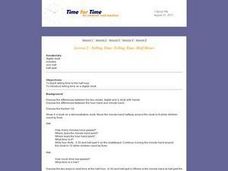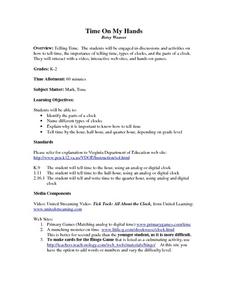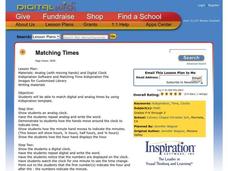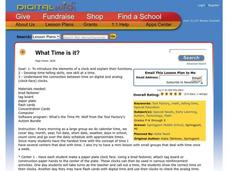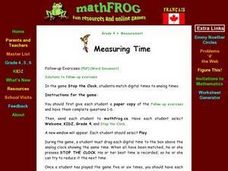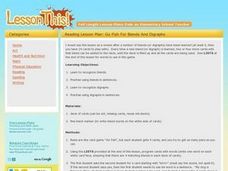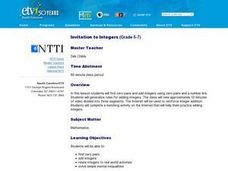Time for Time
Telling Time: Telling Time: Half Hours
The whole class discusses the differences between the two clocks: digital and a clock with hands. They discuss the differences between the hour hand and minute hand. Students are taught telling time to the half hour. They are introduced...
Curated OER
Time On My Hands
Young learners engage in discussions and activities on telling time, different types of clocks, and how the parts of a clock actually work. The engage in interactive websites, hands-on games, and watch a video on the art of the clock and...
Curated OER
It's About Time
In this time worksheet, learners match the clock or watch with the time in numbers. Students complete 6 matching problems total.
Curated OER
Tick Around the Clock
Students examine and discuss the differences between clocks they are shown. Using the internet, they research how people used to tell time before clocks. They review what the long and short hand on the clock represent and practice...
Curated OER
Matching Times
Study digital and analog times on a clock with learners. They will use the Kidspiration template to create a digital and analog time display on the computer. They also display the correct times on both analog and digital clocks when the...
Curated OER
Telling Time as an Everyday Use of Numbers
How can we estimate time? Have your young mathematicians make a clock. Then they compare and contrast types of clocks. They practice writing times in two different ways and make a book about telling time.
Curated OER
Telling Time: Two Ways to Read the Time
Second graders discuss the two different ways of reading time. They study the vocabulary "minutes to" and tell time in five minute intervals. They discuss why it is important to have schedules and students list some schedules that they...
Curated OER
Time & Itineraries Two
Students explore time management by participating in itinerary activities. In this time telling lesson, students identify how to read a clock, how to communicate the time to others and how to plan for events in the day. Students practice...
Curated OER
24-Hour Time
Fifth graders explore the 24-hour clock. They compare the 12-hour clock to the 24-hour clock. Students visit a specified website and play a game called, "Stop The Clock" where they match the correct 12-hour time to the 24-hour clock....
Curated OER
Telling Time By the Hour
First graders explore how to tell time by the hour. They draw the minute and hour hands on a clock to match the time shown by the teacher on the overhead clock. Students write the time shown on a worksheet. They read "The Grouchy Ladybug."
Curated OER
What Time Is It?
Fourth graders distinguish between analog and digital clocks and read time from both types. In this clock reading lesson, 4th graders discuss the types of clocks and the time zones. Students find times in specific time zones. Students...
Curated OER
What Time is it?
Students participate in three centers focused on developing time-telling skills. In this time activity, students create their own paper plate clock face, play "Time Concentration" using times on the hour and half hour, as well as,...
Curated OER
Meeasuring Time
Fourth graders explore telling time on digital and analog clocks. They practice reading the clock and then visit a given website to play a game called, "Stop the Clock." Students match analog times to digital times. They race against...
Curated OER
It's About Time
Students in a kindergarten class are introduced to the concept of time. Individually, they compare the current year to their birth year to discover their age. As a class, they practice reading a digital and analog clock and create their...
Curated OER
Invitation to Integers
Young scholars find zero pairs and add integers using zero pairs and a number line. They generalize rules for adding integers. Students complete a matching activity on the Internet that helps them practice adding integers.
Curated OER
Folk Tales for ESL Students
Using the folk tale "The Man, The Boy, and The Donkey" (linked in the lesson) and a SMART board, teachers can help pupils access multiple skills. Reading the story allows learners to create a timeline of the sequence of events based on...
Curated OER
Individual Horizontal Sundial 2: Cloud/Rain Activity
Young scholars create a sundial to measure local apparent time as it relates to the position of the sun in the sky. In this sundial lesson, students cut and glue gnomon to a sheet of thin cardboard. Young scholars then set the...
Curated OER
Los Trenes de Espa¿¿a
Students identify and read correctly the symbols of a Spanish train schedule. Using maps, they identify and locate major cities and landforms of Spain and practice using a twenty-four hour clock. Using the internet, they navigate a...
Curated OER
Alfy plays "Time Flies"
Third graders use the Internet to go to a math web site to explore, practice and play time telling exercises. They play a time game by moving the clock arms to match a time presented on a button.
Curated OER
The Lady With The Alligator Purse
In this "The Lady With the Alligator Purse" worksheet, students complete multiple worksheets to trace the words in the short story, use alligator purse squares to add one-digit problems and doctor rectangles to subtract, draw hands on...
Curated OER
Go Fish For Blends and Digraphs
Youngsters practice using blends and digraphs. In this early reading lesson, students play a game of "Go Fish" using words that contain a blend or digraph. This allows them to practice recognizing the word and using it in a sentence.
Curated OER
TAKS 3rd Grade Daily Upkeep 4
In this TAKS worksheet, 4th graders identify the time specified on a clock, identify fractional models, and determine models that match equations. The three questions are related to objectives covered on the Texas state test.
Curated OER
Number Recognition Games
Students explore number sense by participating in a math recognition activity. In this number identification lesson, students practice pronouncing names of numbers and matching the number with an amount of objects. Students practice...
Curated OER
Invitation To Integers
Students find zero pairs and add integers using zero pairs and a number line. They generalize rules for adding integers. The class view approximately 10 minutes of video divided into three segments.
